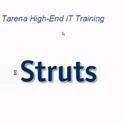Isolation of spacecraft microvibrations is essential for the successful deployment of instruments relying on high-precision pointing. Hexapod platforms represent a promising solution, but the difficulties associated with attaining desirable 3D dynamics within acceptable mass and complexity budgets have led to a minimal practical adoption. This paper addresses the influence of strut boundary conditions (BCs) on system-level mechanical disturbance suppression. Inherent limitations of the traditional all-rotational joint configuration are highlighted and shown to originate in link mass and rotational inertia. A pin-slider BC alternative is proposed and analytically proven to alleviate them in both 2D and 3D. The advantages of the new BC hold for arbitrary parallel manipulators and are demonstrated for several hexapod geometries through numerical tests. A configuration with favourable performance is suggested. Finally, a novel planar joint that allows the physical realisation of the proposed BC is described and validated. Consequently, this work enables the development of platforms for microvibration attenuation that do not require active control.
翻译:航天器微振动分离对于成功部署依靠高精度点的仪器至关重要。 六角平台是一个很有希望的解决方案,但在可接受的质量和复杂预算内实现理想的三维动态所带来的困难已导致很少实际采用。本文件述及了台形边界条件对系统一级机械扰动抑制的影响。强调并显示传统全旋转联合配置的内在局限性源于连结质量和旋转惯性。提议并用分析证明在2D和3D中都能够减轻这种影响。新BC持有的任意平行操纵器的优势,并通过数字测试为若干六分形地形展示了这种优势。建议了具有良好性能的配置。最后,描述并验证了允许实际实现拟议BC的新型平面组合。因此,这项工作使得无需积极控制的微振动加速平台得以开发。




